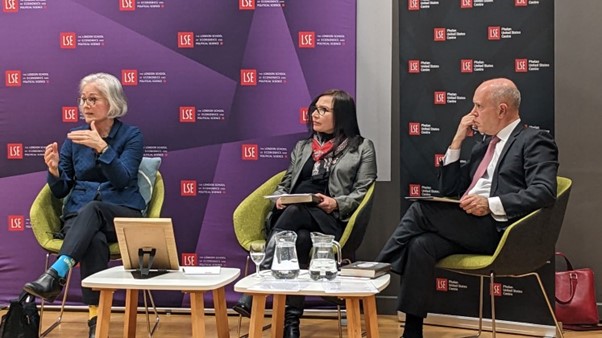 On Friday 24 March the LSE Department of Geography and Environment and the Phelan US Centre co-hosted the in-person event ‘Monumental Denial: U.S. cultural memory and white innocence’ with Laura Pulido, Head of Ethnic Studies and Professor of Geography at the University of Oregon, and Centennial Professor at the Department of Geography and Environment, LSE, and the Phelan US Centre. Grace Brownsberger gives an overview of the event and the Q&A segment.
On Friday 24 March the LSE Department of Geography and Environment and the Phelan US Centre co-hosted the in-person event ‘Monumental Denial: U.S. cultural memory and white innocence’ with Laura Pulido, Head of Ethnic Studies and Professor of Geography at the University of Oregon, and Centennial Professor at the Department of Geography and Environment, LSE, and the Phelan US Centre. Grace Brownsberger gives an overview of the event and the Q&A segment.
On March 24th, the Department of Geography and Environment and the Phelan US Centre hosted the event Monumental Denial: U.S. Cultural Memory and White Innocence with Professor Laura Pulido. Professor Pulido is Professor of Indigenous, Race, and Ethnic Studies and Geography and Head of Ethnic Studies at the University of Oregon and has recently become a Centennial Professor at the Department of Geography and Environment, LSE and LSE’s Phelan United States Centre. She is the author of several notable books including A People’s Guide to Los Angeles, Black, Brown, Yellow and Left: Radical Activism in Los Angeles, and Environmentalism and Economic Justice. Her research explores the myriad of factors that contribute to creating racial inequality as well as the means through which it is denied. She is currently focused on tracking the political ecologies of the Right in the US, including climate denial.
During the event Professor Pulido discussed her recent research analyzing the representation of Black, Brown, and indigenous peoples within National Historical Landmarks across the US. The event began with a Land Acknowledgement, a practice growing in popularity in the US where at the beginning of an event the speaker lists the names of the groups of Indigenous peoples who once occupied the land where the event is taking place or where the speaker is from. The purpose of such an acknowledgment is to recognize that those who once lived on the land have been unjustly displaced. This theme of reflection and representation for those often erased from cultural memory lasted throughout the event.
During the presentation Professor Pulido explained the four ways that those who manage National Historical Landmarks have chosen to handle their not so pleasant past: Erasure, Valorization, Multiculturism, and Acknowledgement. She explained that except for Acknowledgement, the three other methods are all forms of denial which together made-up 92 percent of the 2600 landmarks in the US. Erasure, the complete avoidance of a mention of a Black, Brown, or indigenous person, was found to be very common among National Historical Landmarks, which prefer to speak more about the landmark’s architectural or military significance. In fact, most historical sites in the South neglect to even mention slavery at all.
Valorization is the glorification of a site, leaving out any mention of any possible wrongdoing committed there. An example of Valorization is the Alamo in Texas. Visitors who visit the Alamo today will likely leave seeing it as an example of freedom and traditional American values, not as a site where White settlers battled Mexicans to legalize slavery in what was then Mexican territory. Multiculturalism is the mention of a Black, Brown, or indigenous person, but not what cruelty they suffered. An example brought up for this was Sacagawea, commemorated for assisting Lewis and Clark on their mission West, yet no mention is given for how she was enslaved, and her peoples displaced.
Finally, making up 7.6 percent of National Historical Landmarks is Acknowledgement. To qualify for this category a site must contain at least one mention of racial injustice, yet even sites that meet this requirement tend to focus on more of a labor narrative rather than the cruelty they experienced, emphasizing the economic value those who were enslaved contributed to the foundation of the United States.
After breaking down her research, Professor Pulido explained the impact that misrepresenting history can have on collective memory. Ignoring the injustice Black, Brown, and indigenous groups have experienced throughout history perpetuates White Innocence by denying the role racism has played in the United States.
Following the presentation, a Q&A session was held where Professor Pulido was asked questions about the future of representation in historical sites. She explained that newer sites are starting to handle their past more appropriately, most likely due to the demands from the groups whose histories are misrepresented, yet most sites still have a long way to go. The event then concluded with a question about what the audience could do going forward to counteract this denial. In response she said that the best things to do were to educate yourself before visiting historical sites, to try and share your knowledge with others by visiting with friends and family or even by volunteering there.
- Featured image: “Along the Oregon Trail in Nebraska” (CC BY-NC 2.0) by Snap Man
- Please read our comments policy before commenting.
- Note: This article gives the views of the author, and not the position of USAPP – American Politics and Policy, nor the London School of Economics.
- Shortened URL for this post: https://bit.ly/3UatM5O






